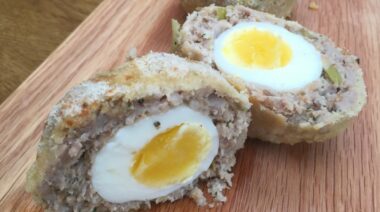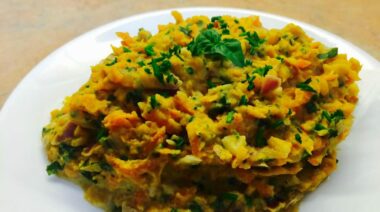Going gluten-free has become a fad. Even bacon packages carry the gluten-free label, and many people consider gluten-free food to be healthier. Sorry to tell you, but gluten-free muffins are still muffins, minus any decent taste or texture (although there are homemade exceptions).
If you have been diagnosed with Celiac disease, you need to avoid gluten and follow medical advice. However, many people simply think if they have any sort of digestive discomfort it has to be gluten, that little protein in wheat. And often, these people even feel better when they eliminate wheat. Is this a placebo effect? Maybe. Or there may be another answer.
If Not Gluten, Then What?
FODMAPs stand for Fermentable Oligosaccharides Disaccharides Monosaccharides and Polyols. These are sugars that are poorly absorbed by many people. FODMAPs are fermented in the gut and cause and general gastric discomfort along with many symptoms related to Irritable Bowel Syndome.
High-FODMAP foods include wheat, dairy, beans, apricots, avocados, and sorbitol. Lactose, the sugar in milk, is also a FODMAP, so it makes sense that some people poorly absorb it. In wheat, the FODMAP culprit is fructan, not gluten. Fructan is an oligosaccharide, which is basically a short sugar chain.
When someone removes wheat from his or her diet, it stands to reason that the overall FODMAP load would decrease, therefore improving digestive symptoms. However, replacing high-FODMAP foods with gluten-free Ho Hos is not ideal for overall health, either. We need a way to figure out whether it is truly a gluten problem or something else.
Assessment by the Loaf
Knowing whether your symptoms are caused by gluten or something else will help you design a nutrient-dense diet without having to make unnecessary sacrifices. Here are three steps to help isolate the underlying problem:
- Locate Quality Sourdough: Find a local baker who makes a quality sourdough bread. By quality, I mean they let the dough ferment for at least 24 hours. It should come as a loaf, not packaged and pre-sliced. Most quality sourdough breads contain gluten, but little FODMAPs. This is because when sourdough is made, bacteria eat many of the carbohydrates in the dough, including the fructans. While it is true that gluten could also be gobbled up by the bacteria, the fermentation would have to last much longer and the end product would probably be inedible.
- Cut Out Gluten: Avoid gluten for at least a week. Try eating the sourdough and note any symptoms or lack thereof.
- Further Explorations: After a week, discuss your concerns with a medical provider and request further testing if necessary. You can also find resources and practitioners who are familiar with FODMAP elimination diets and explore that route.
Fix the Source
Remember, this is a screen, not an assessment. Don’t be that person who feels better and claims they have an evil FODMAP intolerance on Facebook. The screen is meant to help you determine whether or not gluten is the underlying problem. If you tolerate sourdough, you might not have a gluten issue at all.
My objective is to help you avoid the trap of thinking that if anything bothers you, it must be gluten. Make sure you know the source of the problem before digging into unhealthy gluten-free products.
More About Gluten:
- Is Gluten Free as Healthy as You Think? 4 Aspects to Consider
- Is Gluten Free for Everyone?
- Protein Powerhouse: Gluten-Free Mexican Scotch Eggs
- New on Pulse Beat Fit Today
References
1. Engström, Niklas, Ann-Sofie Sandberg, and Nathalie Scheers. “Sourdough Fermentation of Wheat Flour Does Not Prevent the Interaction of Transglutaminase 2 with α2-Gliadin or Gluten.” Nutrients 7 (2015): 2134-144.
2. Fedewa, Amy, and Satish S. C. Rao. “Dietary Fructose Intolerance, Fructan Intolerance and FODMAPs.” Current Gastroenterology Reports Curr Gastroenterol Rep 16, no. 1 (2013): 370.
3. Greco, Luigi, et al “Safety for Patients With Celiac Disease of Baked Goods Made of Wheat Flour Hydrolyzed During Food Processing.” Clinical Gastroenterology and Hepatology 9 (2011): 24-29.
4. Iacovou, Marina, et al. “The Low FODMAP Diet and Its Application in East and Southeast Asia.” J Neurogastroenterol Motil Journal of Neurogastroenterology and Motility 21, no. 4 (2015): 459-70.
5. “Monash University Low FODMAP Diet: Spelt Sourdough Bread by Morpeth Sourdough, a Monash University Low FODMAP Certified Product.” April 14, 2015. Accessed November 12, 2015.
6. Rizzello, C. G., et al. “Highly Efficient Gluten Degradation by Lactobacilli and Fungal Proteases during Food Processing: New Perspectives for Celiac Disease.” APPLIED AND ENVIRONMENTAL MICROBIOLOGY 73, no. 14 (2007): 4499-507.
Photo courtesy of Shutterstock.






